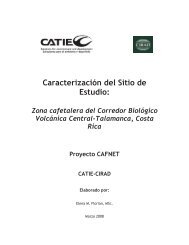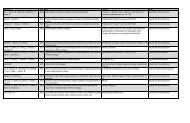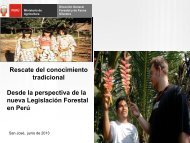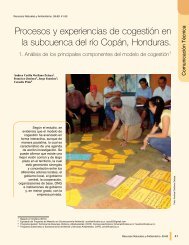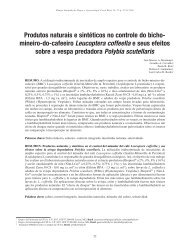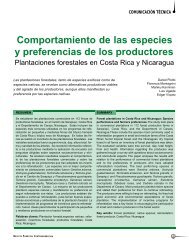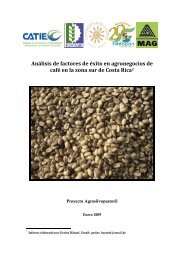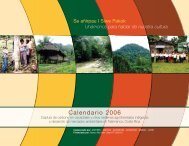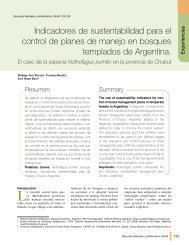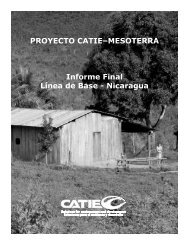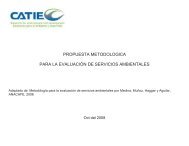Biodiversidad funcional en cafetales: el rol de la diversidad ... - Catie
Biodiversidad funcional en cafetales: el rol de la diversidad ... - Catie
Biodiversidad funcional en cafetales: el rol de la diversidad ... - Catie
You also want an ePaper? Increase the reach of your titles
YUMPU automatically turns print PDFs into web optimized ePapers that Google loves.
A g ro f o r e s te rí a <strong>en</strong> l a s A m é r ic a s Vo l . 9 N º 35 -3 6 2 00 2<br />
Cuadro 2. Descripción <strong>de</strong> <strong>la</strong> pob<strong>la</strong>ción <strong>de</strong> abejas y <strong>la</strong> vegetación <strong>en</strong> los hábitats evaluados durante épocas sin flores <strong>de</strong> café <strong>en</strong> <strong>la</strong><br />
finca San Pedro, Barva <strong>de</strong> Heredia,Costa Rica.<br />
SOL* SBM SAM BR<br />
Abejas **<br />
No. spp.TOTAL 2 12 32 26<br />
Abundancia TOTAL 16 285 487 578<br />
Abundancia Apis 14 83 184 122<br />
Abundancia M<strong>el</strong>iponini 2 173 87 404<br />
Abundancia Halictidae 0 6 67 25<br />
Abundancia Megachilidae 0 3 25 10<br />
Abundancia otros Apidae *** 0 20 124 17<br />
α 0,60 2,53 7,68 5,59<br />
D 0,22 0,73 0,80 0,79<br />
Árboles<br />
No. especies 0 14 4 40<br />
D<strong>en</strong>s. total (individuos ha -1 ) 0 104 496 1343<br />
D<strong>en</strong>s. individuos > 50 cm dap 0 4 0 29<br />
Cobertura (%) 0 37,3 20,8 64,3<br />
α 0 4,9 0,59 8<br />
D 0 0,9 0,56 0,9<br />
Malezas<br />
No. especies 22 25 31 23<br />
Cobertura (%) 4,8 10,7 70,2 18,3<br />
α 4,7 4,6 4,17 3,7<br />
D 0,9 0,9 0,93 0,9<br />
* SOL:cafetal a pl<strong>en</strong>o sol;SBM:cafetal con sombra y baja cobertura <strong>de</strong> malezas;SAM:cafetal con sombra y alta cobertura <strong>de</strong> malezas;BR:Bosque<br />
ripario; α: índice <strong>de</strong> <strong>diversidad</strong> Alfa <strong>de</strong> Fischer; D: índice <strong>de</strong> <strong>diversidad</strong> <strong>de</strong> Simpson.** Las cifras reportadas correspond<strong>en</strong> a los registros tomados<br />
durante <strong>el</strong> tiempo total <strong>de</strong> muestreo (40 h).*** Otros Apidae:abejas <strong>de</strong> <strong>la</strong> familia Apidae, excluy<strong>en</strong>do Apis m<strong>el</strong>lifera y <strong>la</strong> tribu M<strong>el</strong>iponini.<br />
Especies <strong>de</strong> p<strong>la</strong>ntas más atractivas para abejas<br />
Las herbáceas o malezas, fueron <strong>la</strong>s especies que atrajeron<br />
más d<strong>el</strong> 95% <strong>de</strong> abejas <strong>en</strong> <strong>el</strong> tercer estudio. Sin embargo,<br />
<strong>de</strong> <strong>la</strong>s 72 especies <strong>de</strong> malezas solo 15 (20%) fueron<br />
visitadas por abejas, dominando <strong>la</strong> familia<br />
Asteraceae (Cuadro 3).<br />
De julio a octubre d<strong>el</strong> 2000,<strong>la</strong>s especies arbóreas visitadas<br />
por abejas fueron solo 4 (12,1%) <strong>de</strong> <strong>la</strong>s 33 <strong>en</strong> los cuatro<br />
hábitats (Cuadro 3): Inga edulis ( M i m o s o i d e a e ) ,C r o t o n<br />
d r a c o ( E u p h o r b i a c e a e ) ,Syzygium jambos (Myrtaceae) y<br />
Ficus costaricana ( M o r a c e a e ) .Otras especies pued<strong>en</strong> haber<br />
sido visitadas pero <strong>la</strong> altura <strong>de</strong> sus flores hizo difícil registrar<strong>la</strong>s<br />
(<strong>la</strong> altura máxima <strong>de</strong> muestreo fue 7 m).<br />
El género Inga es reportado frecu<strong>en</strong>tem<strong>en</strong>te como<br />
fu<strong>en</strong>te m<strong>el</strong>ífera para abejas (Arce et al 2001; Zevallos y<br />
Pérez 1990), coincidi<strong>en</strong>do con los registros tomados sobre<br />
Inga edulis, que sobresalieron por <strong>la</strong> <strong>diversidad</strong> <strong>de</strong><br />
abejas. En los hábitats don<strong>de</strong> se observó esta especie<br />
(SAM y SBM), fueron los únicos don<strong>de</strong> se registraron<br />
abejas gran<strong>de</strong>s. En BR,estas abejas se observaron sobre<br />
H<strong>el</strong>iconias y <strong>en</strong> arbustos <strong>de</strong> Ham<strong>el</strong>ia pat<strong>en</strong>s (Rubiaceae).<br />
Croton draco sobresalió por <strong>la</strong> profusa visitación<br />
<strong>de</strong> A. m<strong>el</strong>lifera y abejas M<strong>el</strong>iponini (principalm<strong>en</strong>te<br />
Figura 3. Número <strong>de</strong> abejas euglosinas (raíz cuadrada + 0,1)<br />
capturadas 30 minutos <strong>de</strong>spués <strong>de</strong> colocar atray<strong>en</strong>tes<br />
químicos <strong>en</strong> épocas sin flores <strong>de</strong> café <strong>en</strong> <strong>la</strong> finca<br />
San Pedro, Barba <strong>de</strong> Heredia,Costa Rica. SOL:cafetal<br />
a pl<strong>en</strong>o sol; SBM: cafetal con sombra y baja<br />
cobertura <strong>de</strong> malezas; SAM: cafetal con sombra y<br />
alta cobertura <strong>de</strong> malezas; BR: bosque ripario;<br />
TOT:periodo total (0-30 minutos).Las barras indican<br />
<strong>el</strong> error estándar (n=5). Letras iguales indican<br />
que no hubo difer<strong>en</strong>cias significativas (p





